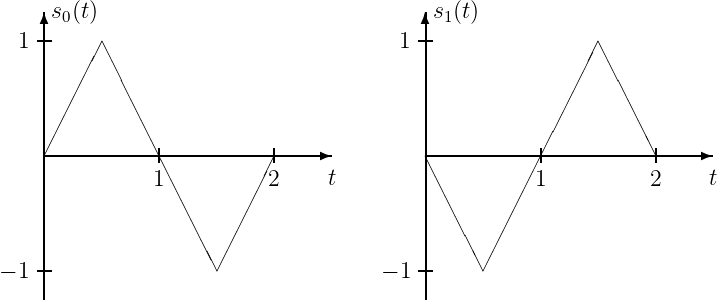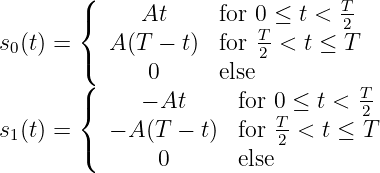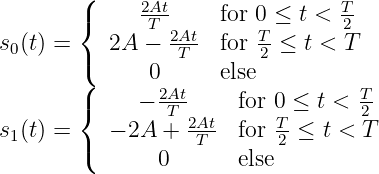- Chapter 6, section 6.2.
Binary Signal Set
The following signal set is used to transmit equally likely messages over an additive white Gaussian noise channel with spectral height :
:

- Draw a block diagram of the receiver which achieves the minimum probability of error for this signal set. Be sure to specify the value of the threshold.
- What is the minimum probability of error achievable with this signal set?
- Consider the following receiver, where
α is a positive constant.
Determine the distribution of the random variable
R as a function ofα for both cases,s 0 (t ) was transmitted ands 1 (t ) was transmitted. Sketch the two density functions and indicate the location of the threshold. - Compute the probability of error achieved by this receiver as a
function of the constant
α . - For what value of
α is the probability of error minimized? Compare with the result from part (b).
Mismatched Filters
The following signal set is employed to transmit equally likely signals over an additive white Gausssian noise channel with spectral height .
.

- Sketch and accurately label the block diagram of the receiver which minimizes the probability of error.
- Compute the probability of error of your receiver from part (a).
- Consider now the following receiver:

Compute the probability of error of this receiver if
g (t ) = sin(πt ). - Repeat part (c) for

- Compare the probabilities of error in parts (b)–(d). Which probability of error is largest? Which is smallest? Explain.
Hint: You may need

Sub-Optimum Receivers
A binary communication system employs the following signals to communicate two equally likely messages over an additive white Gaussian noise channel with spectral height :
:

- Draw a block diagram of the optimum receiver.
- Compute the probability of error achieved by your receiver from part (a).
- Consider now the following suboptimum receiver:

where
g (t ) is given by
Find the distribution of
R for both cases,s 0 (t ) was transmitted ands 1 (t ) was transmitted. - Find the probability of error of the suboptimum receiver and compare with that of the optimum receiver.
- If
g (t ) = sin(π  ) were used in the sub-optimum receiver, would the
resulting probability of error be larger or smaller than the
probability of error achieved with the
) were used in the sub-optimum receiver, would the
resulting probability of error be larger or smaller than the
probability of error achieved with the g (t ) in part (c)? Explain.
Suboptimum Receivers
A binary communication system employs the following signals to communicate two equally likely messages over an additive white Gaussian noise channel with spectral height :
:

- Draw a block diagram of the optimum receiver.
- Compute the probability of error achieved by your receiver from part (a).
- Consider now the following suboptimum receiver:

Find the distribution of
R for both cases,s 0 (t ) was transmitted ands 1 (t ) was transmitted. - Find the probability of error of the suboptimum receiver.
- Assume that the transmitted signal is amplified with a gain
α when the receiver in part (c) is used. How mustα be chosen so that the performance of the receiver in part (c) equals the performance of the optimum receiver without amplification. Bonus: Express the result in part (e) in terms of a loss of SNR measured in dB.